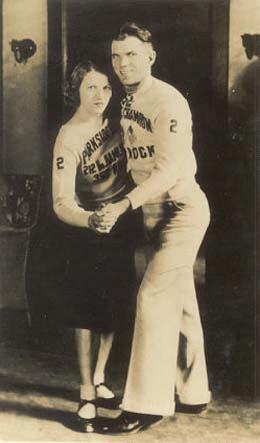On December 7, 1935, a dance marathon/walkathon "Super Show" (so called because the event was even more grueling than a regular dance marathon) closes in Wenatchee after 342 hours (just over 14 days). Dance marathons are human endurance contests in which couples dance almost non-stop for hundreds of hours (as long as a month or two), competing for prize money.
More Grueling Than Grueling
Promoter George C. Cobb had announced his plans to conduct a "Super" at the Victory Dance of the dance marathon/walkathon that had concluded the evening of November 22, 1935, after 1,492 hours (more than two months). The "Super" started on November 23.
Singer Anita O’Day, who competed in dance marathons as a young teenager, remembered that the events tended to emphasize either misery (heats, grinds, contestant teams chained together) or endurance (days dancing) coupled with nightly entertainment. Misery shows were shorter and more brutal (O’Day, p.34).
Tough for Tough Horses
The first George Cobb Wenatchee marathon was an endurance show. The "Super" was a misery show. Thirteen couples were on the floor of Wenatchee’s 1,500-seat Triangle Gardens as the "Super" marathon began. Cobb’s staff and many of the professionals (called "horses" for their ability to endure) who joined his shows had found October weather in Wenatchee brutal going, "affecting some of the toughest horses in the game" (The Billboard, October 12, 1935).
Most or perhaps all of the contestants in the ‘Super’ had competed in the first long marathon, although Kid Chissell, who with his partner Billie Boyd had taken first place in the long show, opted to work the "Super" as a trainer. Trainers aided contestants during the 15-minute rest period they were allotted every hour.
Floor judges were charged with disqualifying anyone whose knees touched the floor or who collapsed during elimination events. Together with the emcee and the professional contestants, they "colluded in 'working heat,' " (Calabria, p.25) meaning that they played to the crowd to arouse a strong emotional response. During a "Super," heat was worked faster and harder than would have been the case in a longer show.
The Drama of Elimination
Although contestants in the Wenatchee ‘Super’ were still fed the marathon-customary 12 meals per day, the heightened drama of steady elimination events without the usual vaudeville-style entertainment employed during most dance marathons meant that tension ran high for contestants as well as for the audience.
The contest ended "on December 7, after 342 hours of steady grinding, featuring derbies, positive elimination, and spot periods. This is said to have been one of the really toughest contests ever staged in this part of the country. Night before closing was featured by an elimination derby between three solo boys, Bill Murray, Nick Taylor, and Walt Farris. Taylor managed to last 11 hours and one minute, with Farris making the round for another hour to make it an even 12 hour grind" (The Billboard, December 28, 1935).
Perhaps the brutality of a 12-hour grind was too much for the Wenatchee audience. The "Super" lost money for George C. Cobb, although as an above-board promoter, he "paid off in full" (The Billboard, December 28, 1935).

